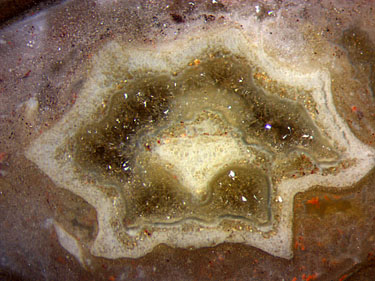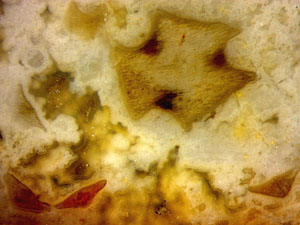Sphenophyllum
bristle brush
The ancient horsetail relative [1] Sphenophyllum
is
well known from its compression fossils in coal bearing formations.
With its slender
herbaceous body, leaves in whorls, and apparently climbing habit it is
surprisingly similar to the flowering
plant Galium aparine,
the cleavers, a common garden weed.




Figs.1-4: Sections of the slender climbing axes having one feature in
common allocating them to Sphenophyllum.
Height of Figs.2-4: 2mm.
Same scale of Figs.1-5.

Sphenophyllum
and
its close relatives have provided showy pictures in the palaeobotany
literature. (Unfortunately, one of the latest publications on the
subject [2] is fraught with erroneous size data. Axis diameters, for
example, can be less than 1mm as in Fig.4 but never as small as 0.2mm
as in [2], Fig.13.)
Crack faces in a sediment with randomly oriented plants
may be confusing and less informative but cross-sections of the slender
stalks show distinctive shapes which can be recognized as Sphenophyllum, even
if slightly tilted or
if looking rather different (Figs.1-4).
Cross-sections of bristle-like leaves seen nearby (Figs.1,2) also
indicate Sphenophyllum.
Fig.5: Seen on the raw surface of a chert boulder from the Permian
Döhlen Basin: One Sphenophyllum
axis section of the usual type below left and two quite uncommon
sections of a brush made of a bunch of bristle-like leaves.
Width of the picture 8mm, same scale as above.
What is seen in Fig.5 has apparently never been pictured before. The
structure
on the right
seems to be a cross-section near the upper end with about 80
bristle-like leaves overtopping
the axis and forming a stiff brush, perhaps as a protection for the tip. An
even bigger brush section with
possibly
more than a hundred bristles is
less well seen above left,
All
pictures have been taken from one chert boulder of 4.7kg found in 2000,
labelled Bu7/89. The boulder is a fragment pried loose from a Permian
chert layer of about 20cm thickness by the Cretaceous sea, embedded
into Cretaceous
sandstone, later laid free by weathering,
then moved and deposited by a glacial stream. Small remains of
Cretaceous sandstone are still adhering to the surface. In this sample,
Sphenophyllum
is restricted to a layer of a few centimeters. Pinnules of
Scolecopteris
are scattered throughout. Moult
fragments of a small crustacean,
probably Uronectes,
are also there.
Finally
it can be stated that plant fossils preserved in chert, although less
conspicuous if looked at from afar, often provide details not seen
before.
H.-J.
Weiss
2018
[1] A. Elgorriagal, I.H.
Escapal, G.W. Rothwell, A.M.F. Tomescu, N.R. Cuneo:
...Evolution of
horsetails (Equisetales) within the ... Sphenopsida.
Am. J.
Botany 105(8): 1–18, 2018.
[2] M. Barthel:
Die Rotliegendflora der Döhlen-Formation. Geologica Saxonica 61 (2)
2015 (2016 released), 105-238.
|
 |
 23 23 |

 23
23





 23
23